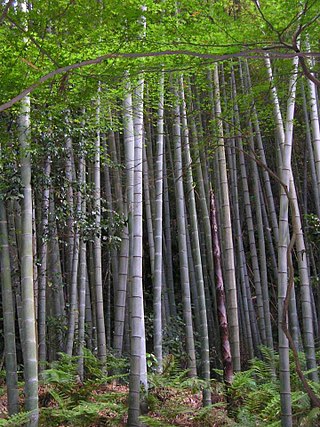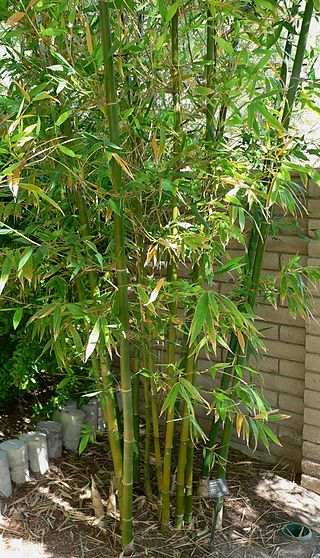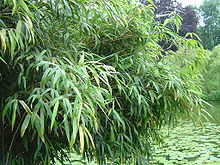
The giant panda, also known as the panda bear or simply panda, is a bear species endemic to China. It is characterised by its bold black-and-white coat and rotund body. The name "giant panda" is sometimes used to distinguish it from the red panda, a neighboring musteloid. Adult individuals average 100 to 115 kg, and are typically 1.2 to 1.9 m long. The species is sexually dimorphic, as males are typically 10 to 20% larger. The fur is white, with black patches around the eyes, ears, legs and shoulders. A thumb is visible on the bear's forepaw, which helps in holding bamboo in place for feeding. Giant pandas have adapted larger molars and expanded temporal fossa to meet their dietary requirements.

Bamboos are a diverse group of mostly evergreen perennial flowering plants making up the subfamily Bambusoideae of the grass family Poaceae. Giant bamboos are the largest members of the grass family, in the case of Dendrocalamus sinicus individual culms reaching a length of 46 meters, up to 36 centimeters in thickness and a weight of up to 450 kilograms. The internodes of bamboos can also be of great length. Kinabaluchloa wrayi has internodes up to 2.5 meters in length. and Arthrostylidium schomburgkii with lower internodes up to 5 meters in length, exceeded in length only by papyrus. By contrast, the culms of the tiny bamboo Raddiella vanessiae of the savannas of French Guiana are only 10–20 millimeters in length by about two millimeters in width. The origin of the word "bamboo" is uncertain, but it probably comes from the Dutch or Portuguese language, which originally borrowed it from Malay or Kannada.

Bambusa is a large genus of clumping bamboos. Most species of Bambusa are rather large, with numerous branches emerging from the nodes, and one or two much larger than the rest. The branches can be as long as 11 m (35 ft).

Drepanostachyum is an Asian genus of medium-sized mountain clumping bamboos in the grass family. They are native to China, Indochina, and the Indian Subcontinent.

Thamnocalamus is a genus of clumping bamboo in the grass family. These species are found from the Himalayas as well as Madagascar and Southern Africa.

Yushania is a genus of bamboo in the grass family.
Neomicrocalamus is an Asian genus of bamboo in the grass family.

Chimonocalamus is a genus of Asian bamboo in the grass family. It is native to China, the eastern Himalayas, and northern Indochina. Some of the species are aromatic and grown as ornamental plants.

Himalayacalamus is an Asian genus of mountain clumping bamboo in the grass family. Species members are found growing at lower altitudes of the Himalaya in Bhutan, Tibet, India, and Nepal.
Ferrocalamus, or iron bamboo, is a genus of Chinese bamboo in the grass family. endemic to China. The plant is known only from southern Yunnan, at elevations of 900 to 1,200 m above sea level.
Melocalamus is a genus of Asian bamboos in the grass family. It is found in lowland areas of Southern China, Indochina, and the eastern part of the Indian Subcontinent.

Fargesia rufa is a woody bamboo native to western China. It is known in Chinese as qingchuan jianzhu, meaning "Qingchuan Fargesia", Qingchuan being a county within the prefecture-level city of Guangyuan in the north of Sichuan. It is found at high elevations in the north of this province as well is in the south of Gansu. The plant is a significant source of food for the giant panda.

Fargesia dracocephala is a woody bamboo native to central China. It is known in Chinese as longtou jianzhu, meaning dragon head Fargesia. The scientific name is derived from Ancient Greek and has the same meaning. It is found at high elevations in the south of Gansu, western Hubei, southern Shaanxi and northern Sichuan. The plant is a significant source of food for the giant panda.

Shibataea kumasaca (倭竹), the ruscus-leaf bamboo or ruscus bamboo, is a species of flowering plant in the grass family, native to mountain slopes in Fujian and Zhejiang provinces in China, and widely cultivated elsewhere. Growing to 1.5 m (4.9 ft) tall, it is a compact, clump-forming evergreen bamboo.

Fargesia murielae, the umbrella bamboo, is a species of flowering plant in the family Poaceae. It is a large, clump-forming evergreen bamboo, closely resembling Fargesia nitida in the same genus, but with yellow canes.
Bashania is a genus of East Asian bamboo in the grass family, native to China and Vietnam.
- Bashania abietinaT.P.Yi & L.Yang – Sichuan
- Bashania fansipanensisT.Q.Nguyen – Vietnam
- Bashania fargesii(E.G.Camus) Keng f. & T.P.Yi – Gansu, Hubei, Shaanxi, Sichuan
- Bashania qingchengshanensisKeng f. & T.P.Yi – Sichuan

Chimonobambusa tumidissinoda is a bamboo species, endemic to southwest Sichuan and northeast Yunnan, China, that has been used for walking sticks since the Han dynasty. Its culms are 2.5–6 meters in height and 1–3 cm in diameter, with large and greatly swollen disk-like nodes. Although it has been utilized since the Han dynasty it somehow escaped scientific description until 1980.

Fargesia nitida, commonly named blue fountain bamboo, is a clumping bamboo native to Szechwan, China. Medium to small and very cold hardy, but not tolerant of very high summer temperatures. This species bloomed in the years 2002–2005, so is not expected to bloom again for another 120 years.

Fargesia robusta is a species of clumping bamboo in the family Poaceae, native to Sichuan, China. Typically 3 m (10 ft) but reaching 4.5 m (15 ft), and with a narrow growth form, it has gained the Royal Horticultural Society's Award of Garden Merit as an ornamental. A number of cultivars are commercially available, including 'Campbell', 'Pingwu', 'Wenchuan', and 'Wolong'.
Fargesia daminiu is a species of bamboo in the family Poaceae, native to Tibet. It is a clumping perennial reaching 2 m (7 ft).















